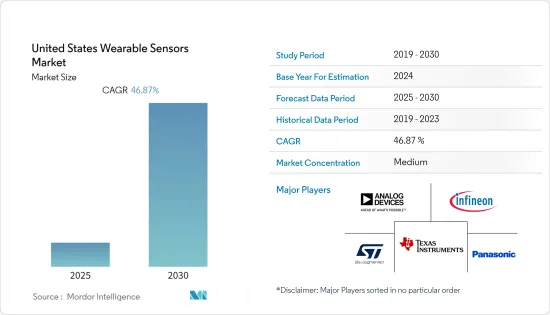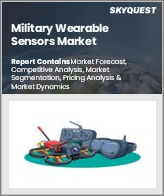
|
시장보고서
상품코드
1628710
미국의 웨어러블 센서 : 시장 점유율 분석, 산업 동향 및 성장 예측(2025-2030년)United States Wearable Sensors - Market Share Analysis, Industry Trends & Statistics, Growth Forecasts (2025 - 2030) |
||||||
미국의 웨어러블 센서 시장은 예측 기간 동안 46.87%의 연평균 복합 성장률(CAGR)을 나타낼 것으로 예상됩니다.

주요 하이라이트
- 시장은 웨어러블 센서가 중요한 역할을 하는 건강 및 피트니스에 대한 인식이 높아짐에 따라 시장이 주도하고 있습니다. 피트니스, 헬스케어, 보안을 위한 웨어러블 기술 등 다양한 응용 분야에 대한 수요 증가로 인해 미국의 웨어러블 센서 시장이 크게 성장하고 있습니다.
- 이 지역에서는 인터넷 보급이 확대되고 기업 및 산업계의 연구비 지출이 증가함에 따라 다양한 용도의 스마트 웨어러블 기술 개발이 활발히 이루어지고 있습니다. 시스코에 따르면 미국에는 2017년 2억 9,800만 명(인구의 92%)에서 2022년 3억 1,700만 명(인구의 94%)의 인터넷 사용자가 존재할 것으로 예상됩니다. 또한, 2022년까지 네트워크 연결 기기의 23%가 모바일 연결이 될 것으로 예상됩니다.
- 코로나19 팬데믹 기간 동안 웨어러블 기기 센서에 대한 수요가 급증했습니다. 웨어러블 기기의 센서는 일선 의료진에게 실시간 데이터를 제공하여 체온이 높은 개인을 신속하게 선별할 수 있도록 도와줍니다.
- 그러나 현재 진행 중인 칩 부족으로 인해 칩의 가용성은 감소할 것으로 예상됩니다. 구매 가능한 제품이 줄어들고 수요가 증가함에 따라 웨어러블 센서와 웨어러블 센서 기반 기기의 가격은 상승할 것으로 예상됩니다.
미국의 웨어러블 센서 시장 동향
웨어러블 피트니스 기기 수요 증가로 시장 견인
- 이 지역의 웨어러블 센서의 주요 시장 중 하나는 스포츠 및 피트니스 시장으로, Nike Fuelband, Jawbone UP, Microsoft Band, Fitbit 등 피트니스 트래킹을 위한 제품이 시장에 출시되고 있습니다.
- 이러한 장치는 몸에 착용하여 걸음 수, 이동 거리, 칼로리 소모량 등 다양한 매개 변수를 추적하고 휴대폰와 동기화하여 매일의 진행 상황을 추적 할 수 있습니다. 이 지역에서 이러한 장치가 널리 보급되는 이유는 사람들의 과체중과 비만이 심각한 문제로 대두되고 있기 때문입니다.
- CDC에 따르면 미국 성인의 65.5%, 어린이의 약 17%가 비만입니다. 이 문제는 불규칙하고 건강에 해로운 식습관과 운동 부족으로 인해 확대되고 있습니다.
- 또한, 수요 증가도 자금 조달 환경을 촉진하고 있습니다. 앱을 통해 수면 환경과 생체 신호를 모니터링하는 스마트 매트리스 제조업체인 에이트슬립(Eight Sleep)은 4,000만 달러의 투자를 유치해 총 6,500만 달러의 자기자본을 조달했습니다. 한편, 혈당, 혈압, 혈중 산소, 심전도, 수분 보충 등 주요 건강 지표를 지속적으로 비침습적으로 모니터링하는 웨어러블 기기를 개발하는 툴라 헬스(Tula Health)는 270만 달러의 투자를 유치했습니다.
웨어러블 기술에 대한 소비자 관점의 변화
- 웨어러블 기기에 대한 소비자의 시각은 지난 10년간 변화하고 있으며, 소비자가 환경과 상호 작용하는 방식을 변화시키는 기능과 진화하는 기술 통합으로 인해 그 인기가 높아지고 있습니다.
- AARP 2020 보고서에 따르면, 피트니스 트래커, 스마트 워치 등 웨어러블 기기에 가장 큰 영향을 미치는 요인은 연령, 소득, 성별이며, 미국 50세 이상, 50-59세, 60-69세, 70세 이상 성인의 웨어러블 기술 사용률은 각각 83%, 87%, 79%였습니다. 웨어러블 기술 사용 연령은 각각 83%, 87%, 81%, 79%, 60-69세, 70세 이상이었습니다.
- 또한, 이러한 웨어러블 기기에 대한 소비자의 시각은 기술 채택이 증가함에 따라 그들의 기대에 부응하는 방향으로 증가하고 있습니다. 기능적 개선이 요구되고 있음에도 불구하고 웨어러블 사용에 관심을 갖는 소비자들이 증가하고 있습니다. 이에 따라 제조업체들은 웨어러블 제품을 다양화하여 소비자가 강조하는 문제를 극복할 수 있는 기회를 창출하고 있습니다.
- 또한, IoT의 성장과 함께 소비자들은 웨어러블을 사용하여 주변의 다른 기기 및 물리적 사물과 정보를 교환하는 데 사용할 것으로 예상됩니다.
미국의 웨어러블 센서 산업 개요
미국의 웨어러블 센서 산업 개요미국의 웨어러블 센서 시장은 소수의 국제적인 기업들과 현지 기업들에 의해 지배되고 있으며, 적당히 파편화되어 있습니다. 웨어러블 스마트 밴드 제조업체의 주요 벤더는 Apple Inc., Huawei Technologies, Polar Electro Oy, Garmin Ltd. 구성되어 있습니다. 이들은 시장 지위와 점유율을 유지하기 위해 최신 기술을 통합하여 제품을 지속적으로 업데이트하고 있습니다.
- 2021년 1월: 구글은 21억 달러에 Fitbit 인수를 완료했습니다. 구글은 이전에 Fitbit의 계획적인 운영과 건강 데이터 활용에 대한 일련의 약속을 한 바 있습니다. 인수 후 구글은 웨어러블 기기와 Fitbit Premium의 개인화된 고려 사항을 결합하여 건강 및 웰빙 분야에 대응할 수 있습니다. 웨어러블 기기에 대한 수요 증가는 미국 시장에서 웨어러블 센서에 대한 수요를 촉진할 것으로 예상됩니다.
기타 혜택 :
- 엑셀 형식 시장 예측(ME) 시트
- 3개월간의 애널리스트 지원
목차
제1장 서론
- 조사의 전제조건과 시장 정의
- 조사 범위
제2장 조사 방법
제3장 주요 요약
제4장 시장 역학
- 시장 개요
- 산업의 매력 - Porter의 Five Forces 분석
- 신규 진출업체의 위협
- 바이어의 교섭력
- 공급 기업의 교섭력
- 대체품의 위협
- 경쟁 기업간 경쟁 관계
- 시장 성장 촉진요인
- 시장 성장 억제요인
- 산업 밸류체인 분석
- 시장에 대한 COVID-19의 영향 평가
- 기술 현황
- 주요 기술 개요(MEMS, CMOS 등)
제5장 시장 세분화
- 유형별
- 건강 센서
- 환경 센서
- MEMS 센서
- 모션 센서
- 기타
- 디바이스별
- 리스트 웨어
- 보디 웨어 및 신발
- 기타
- 용도별
- 헬스 및 웰니스
- 안전 모니터링
- 가정 재활치료
- 기타
제6장 경쟁 구도
- 기업 개요
- STMicroelectronics
- Infineon Technologies AG
- Texas Instruments Incorporated
- Analog Devices Inc.
- InvenSense Inc.
- Freescale Semiconductor Inc
- Panasonic Corporation
- NXP Semiconductors N.V.
- TE Connectivity Ltd.
- Bosch Sensortec GmbH(Robert Bosch GmbH)
제7장 투자 분석
제8장 시장 기회와 향후 동향
LSH 25.01.22The United States Wearable Sensors Market is expected to register a CAGR of 46.87% during the forecast period.

Key Highlights
- The market is driven due to the rising awareness of health and fitness, where wearable sensors play a vital role. Increasing demand across various application sectors such as wearable technology for fitness, healthcare, and security is driving the U.S. wearable sensors market to grow lucratively.
- The rising penetration of the internet and increasing expenditure on research by enterprises and industries in the region is driving the development of smart wearable technology for several applications. According to Cisco, in the United States, there are expected to be 317 million total Internet users (94% of the population) by 2022, up from 298 million (92% of the population) in 2017. Further, 23% of all networked devices are expected to be mobile-connected by 2022.
- During the COVID-19 outbreak, the demand for wearable devices' sensors that offer real-time data to frontline healthcare workers and let them quickly screen individuals with a high temperature skyrocketed.
- However, the ongoing chip shortage is expected to result in a decline in chip availability. As fewer products become available to buy, and with increasing demands, prices of wearable sensors and wearable sensor-based devices are expected to increase.
US Wearable Sensors Market Trends
Increase in demand of wearable fitness devices is driving the market
- One of the major markets for wearable sensors in this region is the sports and fitness market. Products like Nike Fuelband, Jawbone UP, Microsoft Band, and Fitbit have come into the market that is there for fitness tracking.
- These devices are worn on the body to track various parameters such as steps taken, distance traveled, calories burned, etc., and can be synced with the phone to track the progress daily. These devices are getting popular in this region because of the serious problem of people being overweight and obese.
- In the USA, according to CDC, 65.5% of adults and around 17% of children are obese. This problem is growing because of the irregular, unhealthy diet and the lack of exercise.
- Moreover, the rise in demand is also encouraging the funding environment. Eight Sleep, maker of a smart mattress that monitors the sleep environment and vital signs through an app, raised USD 40 million, bringing its total equity funding to almost USD 65 million. Whereas Tula Health, the developer of a wearable device that continuously and non-invasively monitors blood glucose, blood pressure, blood oxygen, EKG, and hydration, among other key health metrics, raised USD 2.7 million.
Changing consumer perspective towards wearable technology
- Consumer perspectives towards wearable devices are changing in the last decade owing to features and evolving technology integration that is changing the way consumers interact with the environment, and their popularity is growing.
- Age, income, and gender are the most influencing factor among these wearable devices, such as fitness trackers and smartwatches. According to AARP 2020 report, the age of usage of wearable technology among United States adults aged 50 years and older, between 50-59 years, between 60-69 years, and between 70 years and plus accounted for 83%, 87%, 81%, and 79% respectively.
- Further, the consumer perspective towards these wearable devices is increasing towards meeting their expectation with the technology adoption rising. Despite the need for improved functionality, an increasing number of consumers are interested in using wearables. This creates opportunities for manufacturers to diversify their wearables offerings and overcome the issues highlighted by consumers.
- Moreover, with the growth of IoT, consumers feel that they will be using wearables to exchange information with other devices and physical things around them.
US Wearable Sensors Industry Overview
The wearable sensors market in the United States is dominated by few international players amongst local players and is moderately fragmented. Major vendors of wearable smart bands manufacturers consist of Apple Inc., Huawei Technologies Co. Ltd, Polar Electro Oy, Garmin Ltd, Fitbit Inc., Xiaomi Corporation, and Samsung Electronics Co. Ltd. They keep on updating their products by embedding the latest technologies to retain their market position and share.
- January 2021: Google has completed its USD 2.1 billion acquisition of Fitbit. Google had earlier made a series of commitments about its planned operation of Fitbit and use of its health data. Post the acquisition; Google will be able to cater to the health and wellness sector with the help of wearable devices when combined with Fitbit Premium's personalized insights. The increase in demand for wearable devices is expected to drive the demand for wearable sensors in the United States Market.
Additional Benefits:
- The market estimate (ME) sheet in Excel format
- 3 months of analyst support
TABLE OF CONTENTS
1 INTRODUCTION
- 1.1 Study Assumptions and Market Definition
- 1.2 Scope of the Study
2 RESEARCH METHODOLOGY
3 EXECUTIVE SUMMARY
4 MARKET DYNAMICS
- 4.1 Market Overview
- 4.2 Industry Attractiveness - Porter's Five Force Analysis
- 4.2.1 Threat of New Entrants
- 4.2.2 Bargaining Power of Buyers
- 4.2.3 Bargaining Power of Suppliers
- 4.2.4 Threat of Substitute Products
- 4.2.5 Intensity of Competitive Rivalry
- 4.3 Market Drivers
- 4.4 Market Restraints
- 4.5 Industry Value Chain Analysis
- 4.6 Assessment of the Impact of COVID-19 on the Market
- 4.7 Technology Snapshot
- 4.7.1 Key technology overview (MEMS, CMOS, etc)
5 MARKET SEGMENTATION
- 5.1 By Type
- 5.1.1 Health Sensors
- 5.1.2 Environmental Sensors
- 5.1.3 MEMS Sensors
- 5.1.4 Motion Sensors
- 5.1.5 Others
- 5.2 By Device
- 5.2.1 Wristwear
- 5.2.2 Bodywear and Footwear
- 5.2.3 Others
- 5.3 By Application
- 5.3.1 Health and Wellness
- 5.3.2 Safety Monitoring
- 5.3.3 Home Rehabilitation
- 5.3.4 Others
6 COMPETITIVE LANDSCAPE
- 6.1 Company Profiles
- 6.1.1 STMicroelectronics
- 6.1.2 Infineon Technologies AG
- 6.1.3 Texas Instruments Incorporated
- 6.1.4 Analog Devices Inc.
- 6.1.5 InvenSense Inc.
- 6.1.6 Freescale Semiconductor Inc
- 6.1.7 Panasonic Corporation
- 6.1.8 NXP Semiconductors N.V.
- 6.1.9 TE Connectivity Ltd.
- 6.1.10 Bosch Sensortec GmbH (Robert Bosch GmbH)



















